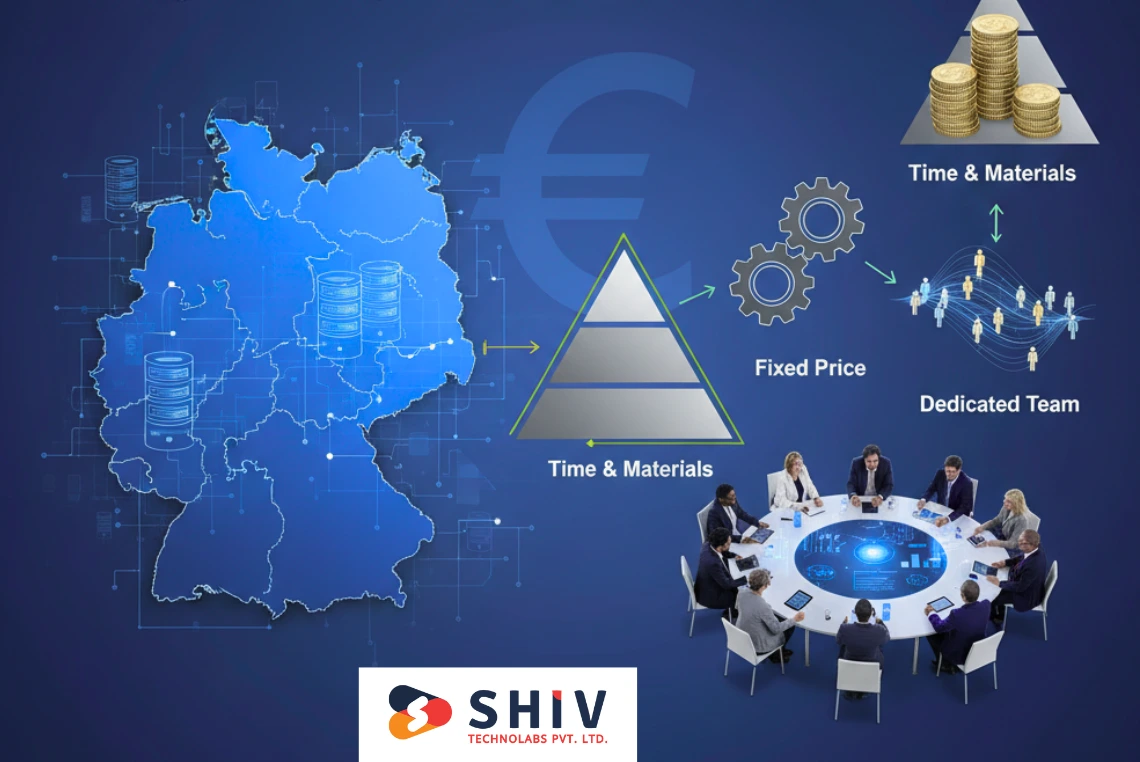Table of Contents
Companies across Germany face rising pressure to deliver software faster while keeping hiring stable. Many teams now depend on flexible staffing support to match project demand. An IT staff augmentation company in Germany helps teams add skilled developers without long hiring cycles. This model allows companies to stay competitive while managing costs with clarity.
IT staff augmentation in Germany works well for firms that want steady progress without heavy internal recruiting work. It supports businesses that need skilled talent for cloud, mobile, AI, or complex backend projects. It also helps teams that already use IT outsourcing in Germany and want more control over daily work.
German tech leaders use this approach when they need skilled developers quickly while keeping their internal plans on track. It also helps companies hire developers in Germany when the local market feels tight or slow.
Key benefits of IT staff augmentation in Germany:
- Faster access to skilled developers
- Lower hiring pressure on internal HR teams
- Direct control over tasks and delivery
- Easy scaling for short or long projects
What Makes IT Staff Augmentation in Germany a Smart Choice for Tech Leaders?
Why are German tech leaders shifting to flexible staffing models?
Many German companies face a shortage of skilled talent, especially in software roles. Teams need experienced developers faster than traditional hiring can support. IT staffing in Germany helps companies fill important roles without slowing project delivery.
Flexible models also lower pressure during busy cycles. Teams can add experts when needed and reduce team size later without HR delays. Companies also gain clarity on project progress because augmented developers work directly with internal managers.
Key reasons behind this shift:
- Talent gaps in the local market
- Speed of onboarding
- Shorter hiring cycles
- Better cost control
How does staff augmentation compare to traditional hiring and full outsourcing?
Comparison of Hiring Models for Tech Teams in Germany
| Model Type | Time to Hire | Cost Predictability | Control Over Work | Flexibility | Typical Use Cases |
|---|---|---|---|---|---|
| In-house | Slow | Moderate | High | Low | Long-term team building |
| Staff augmentation | Fast | High | High | High | Scaling tech teams quickly |
| IT outsourcing | Moderate | High | Low | High | Fully external project delivery |
How Do Pricing Models for IT Staff Augmentation in Germany Work?

Clear pricing helps German tech leaders plan projects with less stress and guesswork. When you understand typical models, you can match budget, risk, and delivery goals with confidence.
Most providers keep their structure transparent, so you can forecast IT staff augmentation costs in Germany with better accuracy. This clarity supports long-term planning, even when project scope grows or new skills are required.
Pricing also affects how fast you can hire developers in Germany and how much control you keep over your team. Different models work better for startups, SMEs, or large enterprises with complex roadmaps.
What are the main pricing structures used in Germany?
Most providers follow a few standard patterns for German clients. Each pattern matches a different growth stage, project size, and risk profile. Hourly, monthly, project-based, and dedicated team models appear most often across the market.
When you study these options, you understand how the IT staff augmentation cost in Germany changes with contract style. This also helps you choose a model that fits how you plan to hire developers in Germany for current and future work.
Common Pricing Models for IT Staff Augmentation in Germany
| Pricing Model | When It Fits Best | Suitable Company Size | Key Notes |
|---|---|---|---|
| Hourly | Short tasks, audits, or urgent fixes | Startup, SME | High flexibility, but monthly spend can change often |
| Monthly | Ongoing product work with stable roadmap | SME, Enterprise | Predictable billing with close day-to-day teamwork |
| Project-based | Clear scope, fixed features, and defined deadlines | Startup, SME | One agreed price, but scope changes may raise cost |
| Dedicated team | Long-term roadmap with continuous releases | SME, Enterprise | Strong team continuity, suits steady development pipeline |
Which factors influence IT staff augmentation cost in Germany?
Several elements shape your final budget, even within the same pricing model. Understanding them helps you control IT staff augmentation costs in Germany before you sign any agreement.
Key cost drivers include:
- Skill level and seniority
- Tech stack and domain
- Experience with the German market
- Contract duration
- Team size
- Engagement model
These points decide not just rates, but also the long-term value you gain from each augmented developer.
Which Pricing Model Fits Startups, SMEs, and Enterprises in Germany?
What pricing model suits startups with limited budgets?
Startups in Germany usually work with tight funds and fast-changing plans. They cannot wait months to bring the first release to market. In this case, hourly pricing or a small dedicated team fits very well.
Hourly pricing helps early-stage founders test ideas without heavy long-term commitments. You can start with a few hours per week, then grow when traction appears. A small dedicated team also works on core product work when you need stable focus each month.
With staff augmentation, startups access senior talent without building a full in-house department. The external partner handles sourcing and HR, while the startup keeps direct control over daily work. This model supports fast experiments while keeping monthly risk under control.
How do SMEs pick between hourly and monthly models?
Small and mid-sized companies in Germany already run active products and support clients. They need a balance between flexibility, predictability, and delivery speed. For them, the choice often sits between hourly and monthly pricing.
Hourly pricing supports short-term tasks, migrations, and audits. It works well when you need a few specialists for a limited time. Monthly pricing suits product teams that add regular features and new integrations.
Many SMEs also mix staff augmentation with IT outsourcing in Germany for certain modules. Core systems stay close to the internal team, while side projects or maintenance move to external vendors. This blend helps SMEs react to market needs without stretching internal teams too far.
What should enterprises consider when scaling augmented teams long-term?
Enterprises in Germany manage large portfolios, strict rules, and long roadmaps. For them, dedicated teams or larger monthly agreements usually fit best. These models provide stable capacity and deeper product knowledge over time.
Long-term staff augmentation calls for strong structure and careful partner selection. Large firms need clear service levels, mature processes, and regular reporting from the partner side. Security, legal, and compliance standards must align with internal rules and industry needs.
Key decision points for enterprises often include:
- How fast the partner can add or replace developers
- How the partner supports knowledge transfer and documentation
- How well the team follows existing tools and workflows
- How the partner manages data protection and access rights
When these points are clear from the start, enterprises gain a stable model for scaling teams. Staff augmentation then acts as a reliable way to support long-term digital plans without constant hiring cycles.
How to Choose the Right Developers for Your German IT Projects?
What skills should a German tech leader look for in augmented developers?
Picking the right developers for your German projects directly affects speed, quality, and long-term success. Staff augmentation gives you access to profiles that match your stack, industry, and delivery goals closely. You still need a clear standard for skills, mindset, and communication before you hire software developers in Germany.
A structured checklist helps your team judge candidates quickly and fairly during IT staffing in Germany projects. Focus on technical depth, business understanding, and soft skills that support remote collaboration across regions. Key skills to check include the following points for every potential team member profile carefully.
Important skills to look for:
- Strong core tech skills
- Cloud, DevOps, or AI, where needed
- Experience in your domain (fintech, logistics, SaaS, etc.)
- Clear English communication, plus German where required
- Proven work with remote or distributed teams
How do in-house vs remote developers in Germany compare?
Many German companies still prefer local teams, yet remote talent now plays a key role in roadmaps. When you compare in-house vs remote developers in Germany, you see trade-offs across cost, speed, and control. The table below gives a quick view for tech leaders planning their next hiring wave.
In-House vs Remote Developers for German Companies
| Factor | In-house Developers | Remote / Augmented Developers |
|---|---|---|
| Cost | Higher salary, benefits, and office overhead | More flexible cost, often lower total spend per role |
| Time to hire | Slow due to notice periods and local competition | Faster access through partner pool and wider markets |
| Flexibility of scaling | Hard to grow or shrink team in short time | Easier to adjust team size through contract changes |
| Access to niche skills | Limited to local network and relocation interest | Wider reach across regions and specialist communities |
| Cultural alignment | Strong local culture and on-site interaction | Needs clear communication habits and shared working rules |
| Management effort | Direct daily management with face-to-face contact | Requires good processes, tools, and clear expectations |
How can staff augmentation reduce delivery risks and project delays?
Delivery risk stays high when a small internal team consistently carries every project phase alone. Staff augmentation adds resilience because you can backfill roles and add strength during sensitive milestones. This approach reduces pressure on managers and protects deadlines when plans change or new tasks appear suddenly.
Ways staff augmentation reduces risk:
- Faster replacement if someone leaves
- Access to backup specialists
- Support for peak workloads
What Are the Real Costs of Hiring Developers in Germany?
What are standard hourly and monthly ranges for developers in Germany?
Cost planning starts with clear rate ranges for every role, from junior to advanced specialist developers. When you understand these numbers, you can compare staff augmentation against hiring or outsourcing choices with better clarity. That insight also helps you discuss IT staff augmentation costs in Germany with partners from a stronger position.
Rates vary by city, tech stack, and project risk, yet some patterns appear across the German market. The table below shows sample ranges you might see when you use IT staff augmentation in Germany.
Example Cost Ranges for Different Developer Levels in Germany
| Role level | Typical hourly rate (EUR) | Typical monthly rate (EUR) |
|---|---|---|
| Junior | 35–50 | 5,600–8,000 |
| Mid | 50–75 | 8,000–12,000 |
| Senior | 75–110 | 12,000–17,500 |
| Specialist | 90–130 | 14,500–20,800 |
How do skill level and role type change your final budget?
Your budget changes quickly when needs move from simple fixes toward advanced architecture or data-heavy features. You should tie the IT staff augmentation cost in Germany to the exact roles that match your roadmap.
Key role types that affect cost include:
- Full-stack developers
- Backend or frontend specialists
- DevOps and cloud engineers
- QA and test automation
- AI and ML developers
Why Is IT Staff Augmentation Often Better Than Full Outsourcing in Germany?
What control do you retain when you use staff augmentation?
With IT staff augmentation in Germany, your internal leaders still guide product direction and priorities every day. Augmented developers follow your sprint planning, tools, review rules, and release flow under your direct supervision. You keep control instead of handing every decision to IT outsourcing in Germany to partners that work alone.
How does staff augmentation support fast scaling up or down?
Staff augmentation lets you change team size faster than classic hiring paths inside Germany or abroad. You can agree on adjustments with your partner without running full hiring or exit steps for every change.
Key advantages include:
- Add or reduce team size with less friction
- Keep product ownership inside your company
- Avoid long HR cycles for short-term needs
How Can You Select the Right IT Staff Augmentation Partner in Germany?
What questions should you ask a potential staff augmentation vendor?
Strong partners answer detailed questions with clear proof, not vague promises or confusing marketing phrases. Before you sign, treat early talks as careful interviews with an it staff augmentation company in Germany.
Important questions include:
- How do you screen and test developers?
- What tech stacks do you support?
- What is your average time to fill a role?
- How do you handle replacements?
- What security and compliance standards do you follow?
What red flags should tech leaders in Germany watch out for?
You protect your product when you spot warning signs very early in your review process. These points strongly suggest you should not hire developers in Germany through that vendor at all. You also should not hire software developers in Germany under unclear or risky commercial and delivery terms.
Common red flags:
- Very low pricing without a clear reason
- No direct access to developers
- Vague contracts and unclear deliverables
- No case studies or client references
FAQs on IT Staff Augmentation in Germany
What is IT staff augmentation in Germany?
IT staff augmentation in Germany means adding external developers to your internal team for shared delivery. You keep project control while a trusted partner supplies talent and manages sourcing, screening, and basic administration.
How is staff augmentation different from IT outsourcing in Germany?
With IT outsourcing in Germany, a vendor manages the full project, including planning and daily decisions. With staff augmentation, external developers join your team and follow your tools, sprints, and technical direction every week.
Is IT staff augmentation cost in Germany higher than in-house hiring?
Direct hourly or monthly rates can look similar to strong in-house roles in large cities. However, you avoid recruiting costs, long contracts, and extra overhead, so the full project cost often stays lower.
How fast can I hire developers in Germany through staff augmentation?
Partners keep a pool of pre-checked talent ready for German and wider European clients. You can often see first profiles within days instead of months, which protects important delivery dates.
Conclusion
Clear pricing models help German tech leaders plan software projects with lower risk and stronger control. When you understand how staff augmentation compares with direct hiring and full outsourcing, you build faster teams with steady quality. You see how each euro links to delivery speed, code quality, and long-term support across your roadmap. Transparent partners, realistic rate ranges, and the right blend of roles protect both your budget and release dates.
If you are comparing different IT staff augmentation services in Germany, start with a clear view of cost drivers. Add clear rules for control. Decide how much ownership, product knowledge, and technical direction you want to keep inside your organisation. Then match each vendor’s skills, team shape, and working process against those points, not just day rates. A partner like Shiv Technolabs acts as a trusted extension of your team. Staff augmentation then supports growth while keeping waste and delivery risk under control.























